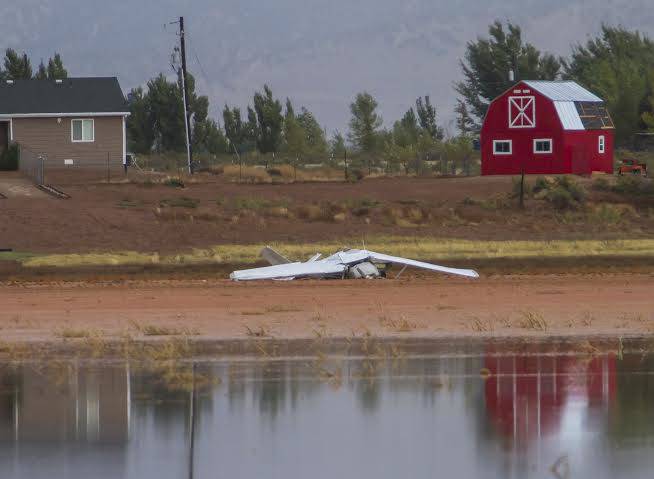
The National Transportation Safety Board has issued a preliminary report on the Cedar City plane crash that killed two Southern Utah University flight instructors.
The NTSB releases information as it becomes available in relation to all plane crash accidents nationwide.The information is always subject to change until the final report is completed.
The report states that on Oct. 5, 2015, at 2:30 p.m., the single engine Cessna 152 with the tail number, N6449M, impacted a dry lake bed approximately 6 miles southwest of the Cedar City Municipal Airport.
The aircraft was owned by Upper Limit Aviation. Killed in the flight were retired Lieutenant Col. Command Pilot Alan Carver, age 50, an airline transport pilot as well as certified flight instructor, and Nathan Stoddard, age 24, a commercial pilot and certified flight instructor. The two pilots were undergoing a company check flight to insure that Stoddard would be qualified to teach and train SUU students enrolled in the Southern Utah University Professional Pilots Program.
The flight departed Cedar City approximately 12:15 p.m. in order to do a ‘check ride,’ an informal test to gauge whether a pilot is prepared enough to instruct students. The two pilots were undergoing the check flight to insure that Stoddard would be qualified to teach and train SUU students enrolled in the Southern Utah University Professional Pilots Program. The weather at the time of departure was clear with very little wind, and there was no flight plan filed. Not having a flight plan filed is customary when doing a check ride in the local area and not flying a cross-country trip.
Witnesses observed the pilot performing various maneuvers in the airplane over the dry lake bed. The area above the lake bed is typically used as a practice area for pilots. A witness observed the airplane in a nose-low descent and stated that it acted like a fluttering leaf before it impacted the ground. The airplane was destroyed by impact forces due to a hard impact into the ground, fatally injuring both Carver and Stoddard.
The airplane was equipped with an on-board flight tracking system similar to a black box on a commercial airliner. The tracking system records the performance of the aircraft in flight. There was no data recorder, which is typically found on commercial airliners and normally records the pilot’s voice as they broadcast over the radio. The tracking system on board the Cessna 152 keeps track of data at intervals of two minutes. The last recorded data point indicated that the airplane was flying approximately 3,500 feet above the ground at a speed of 40 knots—approximately 46 miles per hour.
The stall speed of Cessna 152 airplane is 48 to 55 miles per hour. A stall is when the airplane is not moving forward fast enough to create lift under the wings to keep it flying. If the airplane begins to stall, the pilot lowers the nose to attain the necessary speed to keep the aircraft flying. A stall can be caused by many factors and may not be the actual cause of the crash.
Not long after the accident, in a press release from Southern Utah University, President Scott L Wyatt called it “an incredibly sad time.”
“No one is ever prepared for a tragedy like this,” Wyatt stated. “Many of our pilots have served our country and we appreciate the service they gave to us. We mourn with the pilots’ families, loved ones, the SUU community and City after such a loss.”
The NTSB will continue to investigate the devastating crash.




